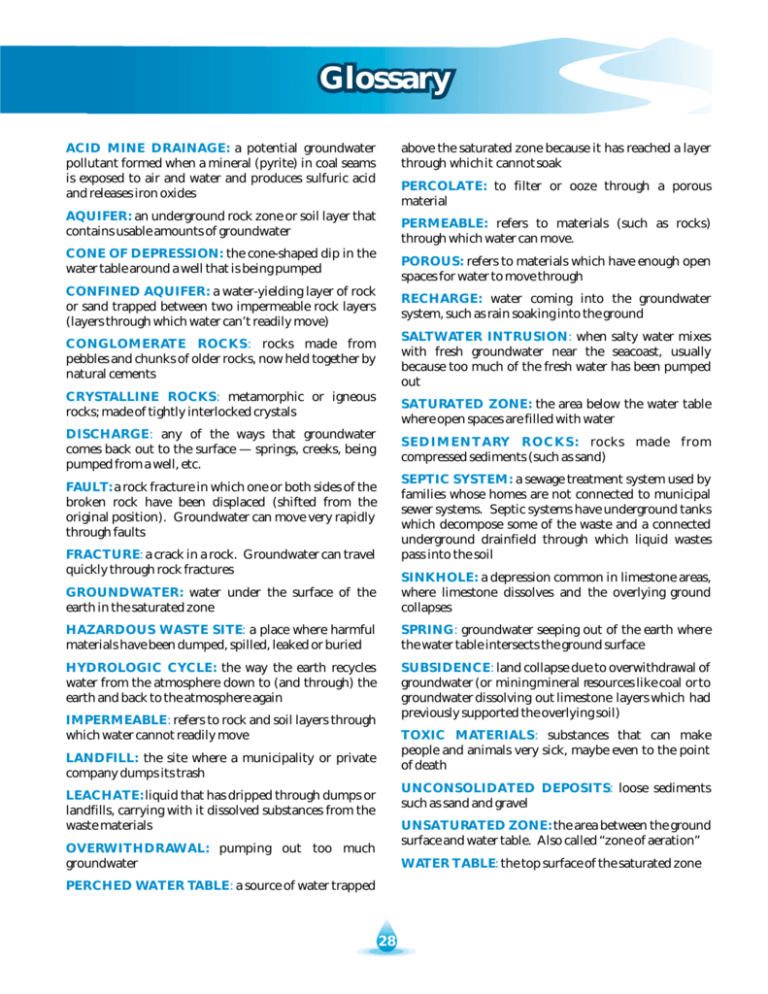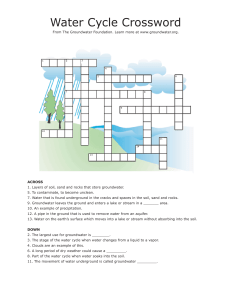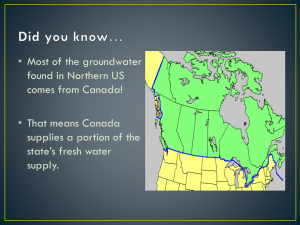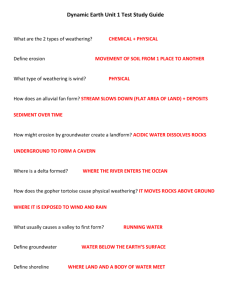Glossary
advertisement

Glossary ACID MINE DRAINAGE: a potential groundwater pollutant formed when a mineral (pyrite) in coal seams is exposed to air and water and produces sulfuric acid and releases iron oxides above the saturated zone because it has reached a layer through which it cannot soak PERCOLATE: to filter or ooze through a porous material AQUIFER: an underground rock zone or soil layer that contains usable amounts of groundwater PERMEABLE: refers to materials (such as rocks) through which water can move. CONE OF DEPRESSION: the cone-shaped dip in the water table around a well that is being pumped POROUS: refers to materials which have enough open spaces for water to move through CONFINED AQUIFER: a water-yielding layer of rock or sand trapped between two impermeable rock layers (layers through which water can’t readily move) RECHARGE: water coming into the groundwater system, such as rain soaking into the ground CONGLOMERATE ROCKS: rocks made from pebbles and chunks of older rocks, now held together by natural cements SALTWATER INTRUSION: when salty water mixes with fresh groundwater near the seacoast, usually because too much of the fresh water has been pumped out CRYSTALLINE ROCKS: metamorphic or igneous rocks; made of tightly interlocked crystals SATURATED ZONE: the area below the water table where open spaces are filled with water DISCHARGE: any of the ways that groundwater comes back out to the surface — springs, creeks, being pumped from a well, etc. SEDIMENTARY ROCKS: rocks made from compressed sediments (such as sand) SEPTIC SYSTEM: a sewage treatment system used by families whose homes are not connected to municipal sewer systems. Septic systems have underground tanks which decompose some of the waste and a connected underground drainfield through which liquid wastes pass into the soil FAULT: a rock fracture in which one or both sides of the broken rock have been displaced (shifted from the original position). Groundwater can move very rapidly through faults FRACTURE: a crack in a rock. Groundwater can travel quickly through rock fractures GROUNDWATER: water under the surface of the earth in the saturated zone SINKHOLE: a depression common in limestone areas, where limestone dissolves and the overlying ground collapses HAZARDOUS WASTE SITE: a place where harmful materials have been dumped, spilled, leaked or buried SPRING: groundwater seeping out of the earth where the water table intersects the ground surface HYDROLOGIC CYCLE: the way the earth recycles water from the atmosphere down to (and through) the earth and back to the atmosphere again SUBSIDENCE: land collapse due to overwithdrawal of groundwater (or mining mineral resources like coal or to groundwater dissolving out limestone layers which had previously supported the overlying soil) IMPERMEABLE: refers to rock and soil layers through which water cannot readily move TOXIC MATERIALS: substances that can make people and animals very sick, maybe even to the point of death LANDFILL: the site where a municipality or private company dumps its trash UNCONSOLIDATED DEPOSITS: loose sediments such as sand and gravel LEACHATE: liquid that has dripped through dumps or landfills, carrying with it dissolved substances from the waste materials UNSATURATED ZONE: the area between the ground surface and water table. Also called “zone of aeration” OVERWITHDRAWAL: pumping out too much groundwater WATER TABLE: the top surface of the saturated zone PERCHED WATER TABLE: a source of water trapped 28









